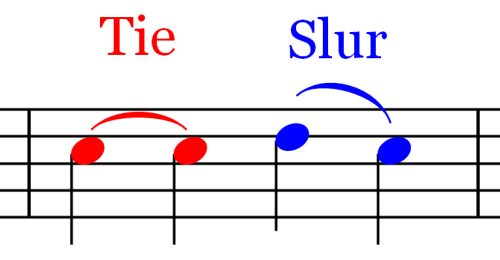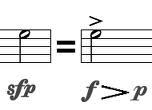There are 5 important music articulation symbols you need to know if you sing or play a musical instrument. They are: 1) staccato, 2) slur, 3) accent, 4) sforzando, and 5) tenuto. Taking the time to really understand these symbols and apply them will really move you’re music playing to a whole new level.
Staccato
A staccato note has a little dot placed right above or below the notehead (depending on the direction of the stems). The Italian word staccato literally means “detached”. So, we want to play each staccato note as short and detached as possible.
There should be a clean break in sound or a little bit of silence after the initial sudden attack of the note. Why is this? Because we are actually cutting short the full note value or chopping off the end of the note by releasing it immediately.
Staccato notes are separated from each other by a quick release after its initial sound, thus shortening the duration of the note.
If you need to play several staccato notes in a row, a little bit of space needs to be heard between each of them. For wind players, tongue using a “Dit” syllable for each staccato note to achieve this.
Slur
Slurs are the opposite of staccatos. They look like a long arching line (in the shape of a rainbow) placed above or below two or more notes that are not the same pitch. The term we use to describe how to play slurs is legato.
Legato means to play smoothly without any separation or break between the notes. As you may have guessed, the word legato is Italian for “smooth”.
For bowed instruments, a single bow is used to play slurred notes. Wind instruments only tongue the first note of slur and not the rest. In vocal music, the notes are to be sung in a single breath or by using only one syllable. In the case of both vocalists and wind players, it might sound like this: “tah-ah-ah-ah”.
Slurs can get easily confused with ties. They certainly look similar, so this is understandable. The only difference between the two are whether or not the notes are all the same pitch or different.
 To help you better understand the difference, take a couple of moments to read about ties and slurs.
To help you better understand the difference, take a couple of moments to read about ties and slurs.
Accent
This French term means “expression”. An accent looks like a mini-crescendo placed above or below the notehead. When we see this, we are called to express that note more than the rest of the notes.
In order to play an accented note, you emphasize it by playing it louder than the surrounding notes without an accent marking. This usually means attacking the note a little bit heavier as well. A tonguing syllable to use for wind players is a strong “TAH” or “DAH”.
Sforzando
A sforzando is similar to an accent in that you emphasize the note more than the rest, but it is usually played with more force and an even higher degree of loudness. This may be indicated in your music by sf (sforzato), sfz, or sfp.
In the case of sfp, after the initial loud attack, the sound is brought immediately back down to soft giving it a nice effect.
Sforzando is an Italian word that means “with a strong accent”. It is basically a very sudden and strong accented note using a lot of force on the initial attack.
For wind players, use an even stronger “TAH-aaaa” syllable while tonguing. Remember to bring the dynamic level down to soft immediately after the first attack when you see the sfp marking.
Tenuto
In Italian, tenuto means “held” or “sustained”. The little horizontal line above or below the notehead tells us to play the note full value and not detached.
For wind players, I like to think of this as a slur, but continue to tongue each note lightly. The syllable to use while playing is “dah” for each of the notes marked with a tenuto.
There You Have It…
Get to know these 5 music articulation symbols and experiment with them a little bit in your music. Deciding exactly how to attack and release music notes is half the fun!
Also, spend some time listening to recordings or live performances to give you even more ideas. Enjoy!







THANKS,I AM COMPOSING AND ORCHESTRATING
This is a great explanation of the terms! I will share this page with my music students.
Great Job
thanks this is super useful
it’d be snazzy to have short audio clips of each type of articulation as an audio demo…nothing fancy, just clips 5 seconds or shorter to get an idea.
I played, composed and arranged a lot in my 20’s and 30’s but then for various reasons (eating, paying mortgages, children etc, lol) I slipped out of it all, just never found time, if you know what I mean. A few weeks ago my daughter (in her late 20’s now) asked for my help to arrange and demo record some music for her and her friends. I was flattered and happy to be asked, but, very quickly realized how many small but important details I have forgotten over the years. I have been madly looking up information (thank God for the internet nowadays) and people like you have made it all that much easier for me to quickly refresh and recharge my faltering memory banks. So thank you Teresa Rose people like you have made my life so much easier.
Surely the angel of good karma will rewards your kindness and generosity.